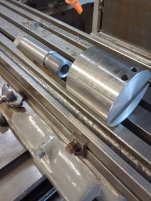Hi hvnlymachining:
You wrote:
"a good support in the lower bore is going to be necessary"
Then you wrote:
"I also think a heavier boring head design is going to be necessary,"
These two things are incompatible...for an outboard bushing to work, the bar must always run concentrically, so your adjustment must come from an insert you can slide sideways through the bar and lock in place with a setscrew.
Fortunately, you don't have to give a damn about how big the bore is... you're going to custom make the bushing anyway.
So don't bother with a boring head... a simple bar with a cross hole and a setscrew hole will be just grand.
Obviously (although it's easy to overlook on a Monday morning at the crack of night when we're all still sleepy) the bar needs to be at least twice as long as the bore plus a little bit, and the cartridge goes across the bar half way along its length.
Turn a big entry cone or radius on the end of the bar so you can fiddle the outboard support bushing over the bar without being able to see it, because, of course, the support bushing will be under the bottom flange and the flange is huge, so your lead-in needs to be generous to allow you to get the bushing in place by feel alone, before you tack the cross strap.
Mill a nice big flat on the cartridge that holds the insert and use a nice hunky setscrew like 3/8:16 NC.
Tap your DOC in with a small hammer on the back of the cartridge...if you just nip the setscrew very gently and put a clock on the bar touching the insert you can adjust it a thou at a time if you want to.
Inserts are good for this because you can just swap them out when you fuck one up...just grab something suitable from your turning inventory or you can even sacrifice a small LH boring bar to make the cartridge from...just chop it off to length and go to town with it.
Something like this but maybe for a TNMG or CCGT insert so it can handle the beating better:

You'll probably have to grind back the heel of the bar to create clearance in the hole though...but if you're going to fuck up the bar in the interests of getting it done anyway...
Cheers
Marcus
www.implant-mechanix.com
www.vancouverwireedm.com





